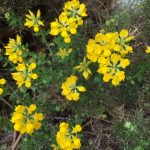Gardening with Anne McKeon
There is absolutely no reason why your autumn/winter garden should not look as good, if not better, than your summer display. It’s all in the planning.
By autumn and early winter your beds and borders can look worn out and generally past their ‘sell by date’, particularly if you opted to plant annual bedding plant and herbaceous flowers. In my opinion it is better to concentrate on shrubs, trees, heathers and so on. In other words, plant more permanent vegetation for an all year round effect, only injecting annuals for a quick fix of additional summer colour.
For years the use of ground cover planting seemed to have lost favour but in these time of ‘no free time’ easy maintenance is the order of the day and so the return of ground cover shrubbery. A bit like bell bottom trousers really, once in fashion, then despised and now back in vogue again! Aside from the obvious advantage of weed control, ground cover plants are also very useful in that they a relatively unaffected by poor weather conditions. Consider them in your winter layout.
Colours can be as important in winter as in summer though much thought should be given to your choices, as colours vary considerably in the low light of winter. Winters are invariably wet so it is worth bearing in mind that wet conditions strengthen some colours, bringing out dense dark browns, silvers and mossy greens.
‘Variety is the spice of life’ and so it should be in your garden. Near the edge or front of beds plant low clumping plants such as Bergenia cordifolia (St. Patrick’s Cabbage), Senecio monroi, Ozothamnus ledifolius (Kerosene plant), the heavily perfumed Sarcacocca humilis, lime tolerant Erica carnea ( winter flowering heathers ), Taxus Summergold (ground cover Yew conifer) and so on. Mid – way into bedsconsider Cornus Midwinter Fire (low – mid sized Dogwood), Salix wehrhahanii, (mid sized bush Willow), Pittosporum Abbottsbury Gold, Thuja Smaragd, (lime green conifer) etc. To the back of your bed or border again consider Cornus ( Dogwood types) along with Viburnum Tinus, Euonymus alatus, Pittosporum Silver Queen, Astelia Silver Spear, Cotoneaster salicifolia, Ilex aquifolium (Holly)and so on. Again the choices are endless.
If planting trees, consider Eucalyptus niphophila (Snow Gum) or from the many ornamental crab apple types such as Malus Golden Hornet or Malus John Downey or possibly from the large family of Rowan/Mountain Ash trees such as Sorbus Commixta or Sorbus Joseph Rock.
Suitable bulbs for winter and early spring effect would be Narcissi (particularly dwarf Daffodil types), Snowdrops Anemone blanda, Cyclamen coum and Allium. Ideally bulbs should be planted in clumps/groups rather than individually for best visual effect.
Dress up in your thermals this winter, brave the elements and venture outdoors to create a winter wonderland in your garden. It’s all in the planning!
Happy Gardening!
Anne.
Garden Checklist.
· Remove fallen leaves from pathways and lawn areas and re-use in the shrubberies and. Leave fallen leaves around base of trees.
· If Virginian creepers and ivy plants have become overgrown, trim back now by approx 3ft away from gutters.
· Check that tree ties and stakes are secure.
· Divide perennial plants.
· Prune early summer flowering heathers.
Anne McKeon of Gum Dearg Teoranta,
Buaile Beag, Bearna, Galway operates a Garden Design & Advisory Service. Anne presents a gardening spot on Galway Bay FM radio every second Thursday morning at 10.50am approx. and writes gardening articles for various publications. To date Anne has also written two gardening books, one for adult beginner gardeners (Don’t Forget Your Shovel) and one for children (Green Acres – Hobby Gardening For Children).
Phone: – (091) 521186 (office)
087 1441623 (mobile)
e. Mail. [email protected]



